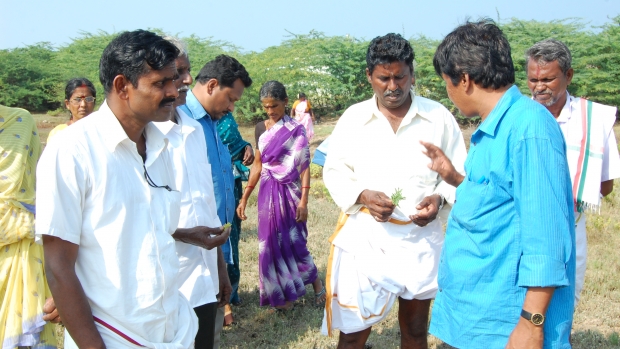Grants :: Small Grant Facilities :: Mangrove restoration: participatory assessment of current practices
Mangrove restoration: participatory assessment of current practices

Assessing mangroves, Tamil Nadu India © MSSRF, 2011
Objectives
The project’s objectives were to assess current techniques for restoring degraded mangroves and for pioneer planting in new areas, as well as the social and economic benefits and constraints of these activities. The project also looked at current institutional mechanisms at the grassroots level and their roles in mangrove restoration and protection. It identified livelihood enhancement and diversification opportunities which can be integrated into restoration programmes, and developed strategies to overcome the technical, social, institutional and policy constraints to planting.
Background
The importance of mangroves was recognized by wetlands managers in India in the early 1980s, leading to a complete turnaround in forest policy from intensive exploitation to full protection. During the early 1990s, management focused on restoration, principally by replanting. The results were generally poor as attention focused on the forest component, neglecting other important aspects such as hydrology and sedimentation processes. The importance of hydrological regimes is now understood but weaknesses still remain. For example, 90% of the mangroves currently being planted are Avicennia marina, neglecting other species in need of regeneration (although in many highly saline areas only the salt-tolerant A. marina can be planted). Second, inadequate attention is given to community livelihood issues. Third, village planning institutions lack the technical, social and economic capacity to sustain mangrove restoration efforts. This project addressed these issues in the states of Tamil Nadu and Andhra Pradesh.
Target beneficiaries
Local communities and Joint Mangrove Management (JMM) stakeholders.
Outputs
- Identification of the strengths and weaknesses of current techniques in mangrove restoration by stakeholders (communities), and identification of opportunities to improve those techniques.
- Identification of the strengths and weaknesses of the participatory process followed by JMM and village institutions.
- Identification of gaps and remedial measures in the roles and responsibilities of different stakeholders, particularly primary stakeholders such as local communities and the state Forest Department (FD).
- Identification of opportunities to enhance income from mangrove planting and restoration, and to reduce poverty amongst mangrove-dependent communities.
Accomplishments and challenges
Stakeholders have indicated that mangrove cover has increased considerably, and that dependence on mangroves for firewood has decreased. However, a weakening of FD involvement with community stakeholders may reduce planting success in future initiatives. Village Forest Councils (VFCs) need to be strengthened and all stakeholder roles clearly defined. Monitoring and evaluation of the FD officials involved in VFCs should be instituted to gain community trust. Welfare schemes in coastal areas need to be integrated with management of mangroves, since these provides the core livelihood security for communities in the region. All-concrete houses should be provided to residents, and policies adopted to promote the supply of gas to mangrove-dependent households.
Contributions to cross-cutting themes
Community participation in mangrove management, and community stewardship of mangroves, is increasingly being recognized as a successful approach towards mangrove conservation in India.
Lessons Learned
Participatory analysis of community perceptions of mangrove management practices is essential to understanding the associations between these practices and communities. It is also necessary to refining future strategies and policies on mangrove restoration and joint management. In most cases, communities have not taken ownership of their mangroves because JMM is perceived locally as an FD project, not a continuous process involving communities. Wherever a strong partnership links communities, the FD and NGOs, the results in terms of both increases in mangrove cover and community empowerment are better and more sustainable.
Project Facts
Country
Location
Tamil Nadu and Andhra Pradesh, India
Topic
Duration
19th Feb 2010 to 1st Feb 2011
MFF Grant Amount
US$17,400
Implementing Partner
Dr V. Selvam
Director
M. S. Swaminathan Research Foundation
111 Cross Street, Taramani Institutional
Area, Taramani, Chennai 600 113, India
Email: vselvam45@hotmail.com
Related Events
Sharing Lessons on Mangrove Restoration - MFF Regional Colloquium
Mamallapuram, near Chennai (Tamil Nadu), India 30 Aug - 31 Aug 2012
A regional colloquium on sharing lessons in mangrove restoration on August 30-31, 2012 in Chennai, India examines the various experiences from MFF countries where mangrove projects have been carried out. The colloquium ...

